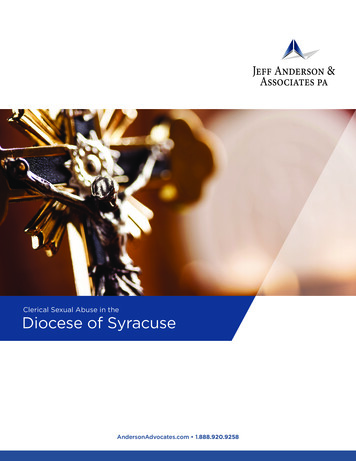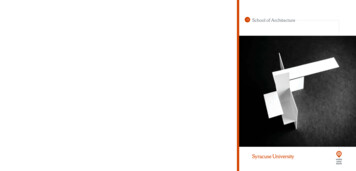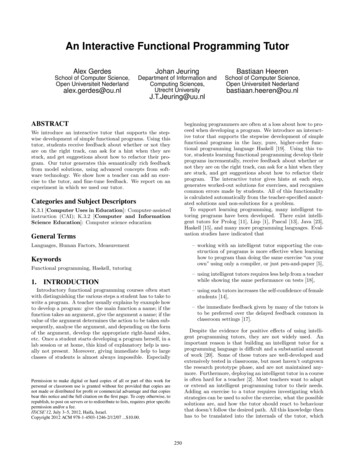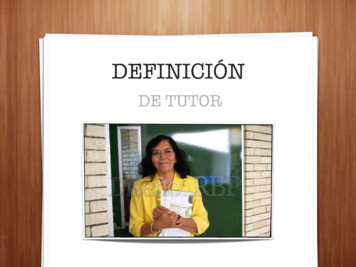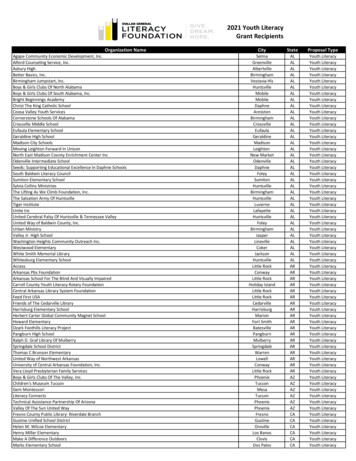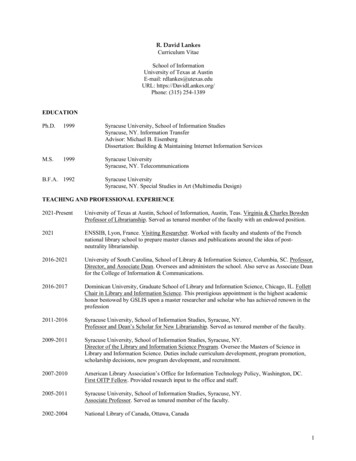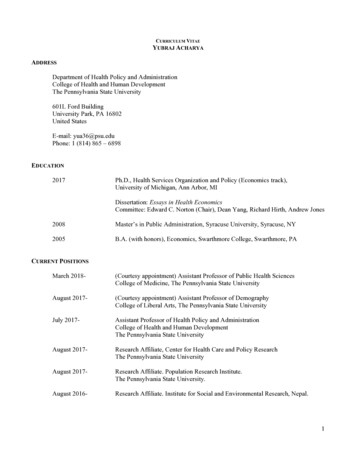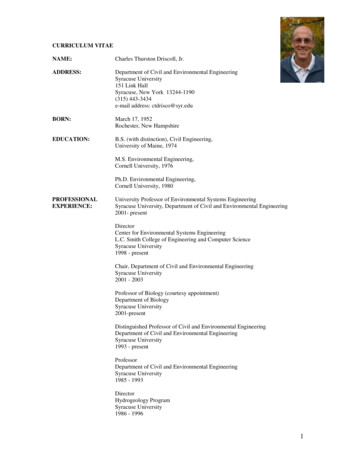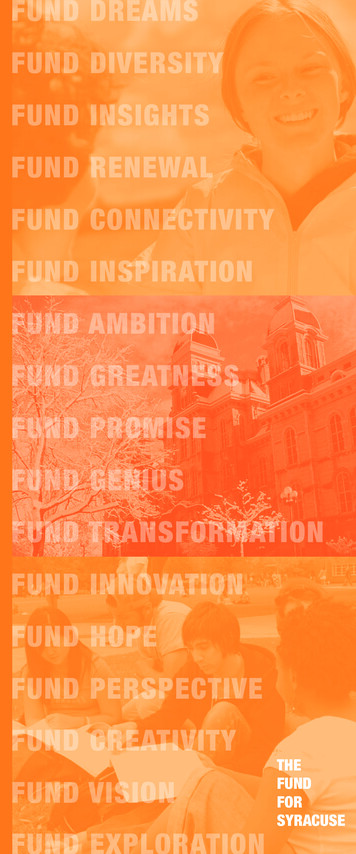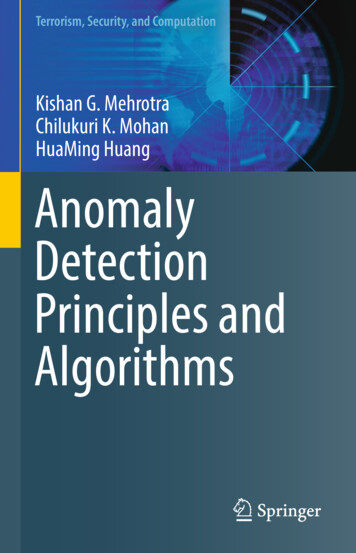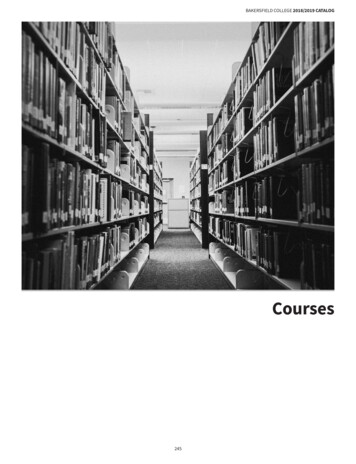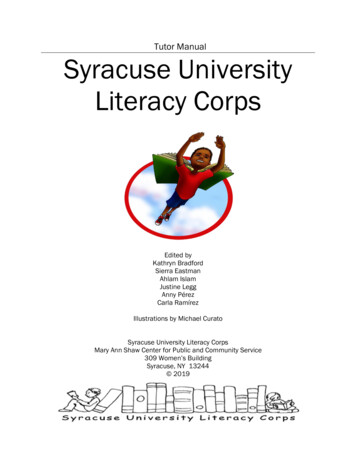
Transcription
Tutor ManualSyracuse UniversityLiteracy CorpsEdited byKathryn BradfordSierra EastmanAhlam IslamJustine LeggAnny PérezCarla RamírezIllustrations by Michael CuratoSyracuse University Literacy CorpsMary Ann Shaw Center for Public and Community Service309 Women’s BuildingSyracuse, NY 13244 2019
Introduction. 3History of the Syracuse University Literacy Corps . 3The Importance of Literacy . 4Words from Tutors. 5Syracuse Schools and Community . 7The City of Syracuse. 7Racial and Ethnic Diversity . 7Poverty in Syracuse . 8The Syracuse City School District (SCSD) . 9SCSD: Languages . 9SCSD: Children & Abilities . 10SCSD: Restorative Justice . 11Syracuse City School District Code of Conduct, Character, and Support . 11Tutor’s Role in Restorative Justice . 11Concerns Regarding Discipline . 12Connecting to Your Classroom Community . 12What to do if you are Concerned about a Child’s Welfare . 13Policies and Procedures . 15Overall Expectations . 15SU Employees/ Organization Volunteers 15Maintain Open Communication. .15Administrative Responsibility .15Professionalism .16Personal Responsibility .16Job Responsibilities: On-Site . 16Appearance. 16Timesheets/Tutoring Logs . 17Attendance Policy . 17Attitude/Demeanor . 18Confidentiality . 18Teacher's Tutor Evaluation .19Site Visits .19Timesheets Audit .19Page ii
Job Responsibilities: Off-Site . 19Electronic Communication . 19Wednesday Procedures . 20Payroll / Timesheets . 20Disciplinary Action Regarding Timesheets . 21Tutor Training & Reflection Sessions .22Tutor’s Program Evaluation . 23Tutor Reports . 23Field Trips to Campus . 23Field Trips Off-Site and Off Campus . 23Transportation Procedures . 24Transportation Request Process . 24Transportation Cancellation Process . 24Weather-Related Cancellations . 25Two-Hour Delays . 25Critical Employee Information & Responsibilities . 26Disciplinary Action Procedures . 26Federal Work-Study Earnings Information . 26Student Employee Rights and Responsibilities . 27Corps Council . 28Position requirements 28Specific Responsibilities .28Time Commitment 28Corps Council Leadership Opportunities .28Co- Chair . . . 28Other Positions. . . .29Extra Work Opportunities . 29Question of the Week . 29Utilizing Your SULC Experience. 30References and Resume . 30Using SULC Experience for Academic Credit . 30Leadership Intern . 30Important Forms . 32Timesheet Calculator 33Page iii
Timesheet . 34Tutor Log .35Tutoring Agreement . 36Teacher’s Tutor and Program Evaluations . 37Tutor Reflections . 39Tutor's Rubric. .40Tutor's Program Evaluation . .41Works Cited . 43Page iv
mSyracuseUniversityLiteracyCorpsPage 2
IntroductionThis section of the manual introduces tutors to Syracuse University Literacy Corps(SULC). It includes SULC history as well as statistical data that supports the importance ofliteracy. Tutors are integral to the success of the Mary Ann Shaw Center for Public andCommunity Service (Shaw Center) Literacy Initiatives. The Shaw Center provides institutionalleadership, support, and coordination for experiential learning through communityengagement that enhances Syracuse University student learning outcomes, persistence, andsuccess.History of Syracuse University Literacy CorpsSyracuse University Literacy Corps (SULC) is a reciprocal learning experience born fromformer President Clinton’s “America Reads Challenge,” which encouraged communitymembers to tutor students to improve literacy rates. Clinton specifically called upon studentsat colleges and universities to help with the challenge. SULC, a response to this charge, is aservice learning experience that mobilizes SU students to tutor students at elementary andsecondary schools in the Syracuse City School District (SCSD) and community-basedorganizations (CBO). The program was piloted in 1997 with 15 tutors at an area elementaryschool. Due to program success, it was later developed into a formal program. Currently, over200 SULC tutors work at 28 different sites during the academic year. While SULC aims toprovide reading practice, the influence on the students of the SCSD goes beyond improvementin reading ability. The friendships and partnerships that result from this collaboration makethe program something both recognizable and exciting.SULC was launched by Pamela Kirwin Heintz, Associate Vice President for Engagementand Director of the Mary Ann Shaw Center for Public and Community Service at SyracuseUniversity. Shaw Center staff, along with former Chancellor Kenneth A. and Mary Ann Shaw,worked to ensure that Syracuse University made significant and positive contributions to theSyracuse community.SULC is made possible through federal funds. The tutors, although consideredvolunteers in the SCSD, are compensated through the Federal Work-Study (FWS) program. Agenerous gift from the Gary and Karen B. Winnick Foundation in the fall of 1999 enabled theShaw Center to hire a full-time program director and expand the number of tutors and sites.The Winnick Foundation continued its support through 2005. Currently, the Division ofAcademic Affairs provides administrative funding and support for SULC.In 2008, Syracuse University joined forces with Say Yes to Education, Inc. and theSyracuse City School District to pilot the Syracuse Say Yes to Education and EconomicDevelopment Demonstration Program. At this time, the Winnick Foundation renewed itssupport of SULC by supporting a staff position to oversee the Say Yes Winnick Fellowsprogram. The Say Yes Winnick Fellows is a program of SULC that provides academic tutoringin support of the Syracuse Say Yes to Education initiative.Page 3
The Importance of LiteracyAccording to Literacy Volunteers of America, Inc. (2002), adult literacy can be definedas “the ability to read, write, and speak English proficiently, to compute and solve problems,and to use technology in order to become a life-long learner and to be effective in the family,in the workplace and in the community.”Literacy is more than a benchmark of academic achievement. Literacy Volunteers ofAmerica explains that very few adults are truly illiterate, yet there are many adults with lowliteracy skills. Considering the amount of text one encounters in daily life, it is clear that beingliterate is an empowering life skill.The following are nationwide statistics about literacy: Approximately 16% of individuals in the United States are performing below a Level 1on the Program on the International Assessment of Adult Competencies (PIAAC)literacy scale (Rampey et al., 2016). Performance at this level indicates an inability tounderstand more than basic vocabulary, as well as understand sentence andparagraph structure and other text features. Illiteracy and low literacy in adulthood can have major health impacts. Low literacy hasbeen linked to higher rates of mortality, poorer management of chronic disease, andincreased rates of hospitalization (Pignone & Dewalt, 2006).Literacy development begins in early childhood with a child’s interaction with booksand reading materials. It then progresses to direct experience with written text and theteaching of literacy skills both in and out of the classroom. Professionals who have dailyinteractions with young children play a major role in the prevention of reading difficulties andthe cultivation of literacy skills (Snow, Burns, and Griffin, 1998). This has been exemplifiedmore recently in the following statistic: "For children identified as poor readers in first grade, exposure to a fairly balancedsmall-group literacy intervention program in kindergarten dramatically reduces theoccurrence of very poor reading performance by the end of first grade" (Scanlon et. al,2005).Page 4
Words from Tutors“The students I work with, despite only being kids, have a rich perspective on life growing upin the city of Syracuse. Thus, working together, we can learn from each other and gleanperspective from one another through the differences in our lives to help us become morewell-rounded citizens of the world.” – Quote from Spring 2015 Tutor“As a Syracuse University Literacy Corps tutor this semester, I have come to value the greatdiversity in the city of Syracuse and the importance of work skills. I have learned to appreciatethe community and improve my interpersonal skills. In this way, I have found my serviceexperience to be of reciprocal benefit, and hope to continue learning from my supervisors,students and the job itself.” – Quote from Fall 2014 Tutor“I learned how much I love to see young people especially succeed. The instant gratificationI felt when a subject finally "clicked" for a student is a feeling I want to continue to partakein.” – Quote from Spring 2019 Tutor“From my work experience with SULC, I learned that it is imperative that I give my work150%. Work ethic is a very important attribute for your brand. I believe SULC helped medevelop skills of responsibility, trustworthiness, and exceptional work ethic through thevarious workshops and work experiences these past 2 years.” – Quote from Fall 2013 Tutor“No matter how small a gesture may seem, it always makes an impact. The ability totransform someone’s educational experience is a great opportunity that not many peopleget.” – Quote from Spring 2016 Tutor“My students were my motivation and they inspire me every day to continue doing what Ilove, working and building relationships with kids. They have truly made an impact on my lifeand I cannot wait to return to SULC.” – Quote from Spring 2014 Tutor“My students inspire me with their resourcefulness, creativity, and compassion. My studentschallenge me to do better. I learn from them all the time.” – Quote from Fall 2012 Tutor“I absolutely love working with children even more that I thought I did. Though it is tough attimes, especially with younger students, it is extremely rewarding to observe how they beginto react when you go into their classroom and were improving their skills from your timetogether.” – Quote from Spring 2018 Tutor“Literacy Corps made me realize that I want a long term career where I can make an impactin the lives of others.” – Quote from Fall 2017 Tutor“I learned so much about working in a diverse environment. I learned a lot about theexperiences my students go through and the expectations others have of them. I learnedabout the importance of a diverse and welcoming education. I learned the importance ofacknowledging adverse set of strengths.” – Quote from Spring 2019 TutorPage 5
Page 6
Syracuse Schools and CommunitySyracuse University Literacy Corps (SULC) mobilizes Syracuse University students’learning experiences as tutors in the greater Syracuse community. Tutors work in a variety ofsettings including schools in the Syracuse City School District (SCSD), neighboring schooldistricts and other SULC partner organizations.For more information on the City of Syracuse and SULC partner schools andorganizations, visit their websites:The City of Syracuse- http://www.syrgov.net/Syracuse City School District- www.syracusecityschools.comEast Syracuse-Minoa Central School District- www.esmschools.orgMost Holy Rosary- www.mhrsyr.orgSolvay Union Free District- www.solvayschools.org/Syracuse Academy of Science Charter Schools- https://www.sascs.org/100 Black Men of Syracuse, Inc.- https://100blackmensyr.org/As a result, there are a variety of expectations in each setting and this section aims tofamiliarize tutors with some aspects of these settings. To work best in a learning environment,it is important to have a basic understanding of the culture of the school and surroundingcommunity. Simply put, culture is the shared set of perspectives, values and behaviors of asocial group or community (McGoldrick, Pearce, & Giordino, 1996). For the purpose of thismanual we’ll use data of the City of Syracuse and the SCSD, our largest partner.The City of SyracuseSyracuse is a medium-sized city located in Onondaga County, Finger Lakes region ofUpstate New York. It is the fifth most populous city in the state of New York and home to over143,000 people (U.S. Census Bureau, 2018). There are 26 neighborhoods in Syracuse, whichreflect the city’s various ethnic population. Many religions are also represented in Syracuse,including Christianity, Islam and Judaism (Syracuse Population, 2019).Racial and Ethnic DiversityThe City of Syracuse and the SCSD are racially and ethnically diverse. In the city ofSyracuse, people of color make up 51.5% of the population (U.S. Census Bureau, 2018). Inthe SCSD, this percentage is 78% (NYSED, 2018a). The following charts illustrate the diversityof the city of Syracuse and the SCSD.Syracuse CityDemographics by Race andOriginWhite50.5%African American29%Hispanic9.1%Asian7%American IndianOr Alaska ----------------------------Foreign Born12.5%(U.S. Census, 2018)SCSD Demographics by RaceWhite8%African-AmericanHispanic/Latino1% 6%22%13%Asian or PacificIslanderAmerican Indian orAlaska NativeMultiracial50%Page 7(NYSED, 2018a)
Poverty in SyracuseIn the last decade, the city’s population has decreased as a result of suburban sprawl,devalued housing stock, and a diminishing tax base. While the city of Syracuse has a range ofpeople living at different socio-economic levels, the poverty rate is significant.88%32.6%General population of SyracusePopulation age 18-64 living in povertySCSD StudentsSCSD Students eligible for Free or Reduced LunchThe poverty rate in Syracuse in 2018 was 32.6%. According to recent census data,46.7% of children under age 18 that live in Syracuse live in poverty (U.S. Census Bureau,2018). In the 2017-2018 school year, 88% of students in the Syracuse City School District(SCSD) were eligible for reduced or free lunch, which has traditionally been used as a markerof economic hardship in public schools (NYSED, 2018a).These rates especially affect racial and ethnic minority students. A recent RutgersUniversity study found that Syracuse, New York had the highest concentration of povertyamong African Americans and Latinos out of the top one hundred largest metropolitan areasin the United States. These high poverty rates disproportionately affected Black and Latinochildren age 11 and under, who make up a significant percentage of the population living inhigh-poverty neighborhoods (Jargowsky, 2015). Given that Black and Latino students makeup more than two-thirds of all SCSD students, a majority of children in this district aredisproportionately affected by poverty (NYSED, 2018a).The poverty rate is important to consider as it directly correlates with literacy andacademic achievement. As Snow, Burns, and Griffin (1998) explain, “low [socioeconomic]status is a group risk factor because children from low income communities are likely tobecome poorer readers than children from more affluent communities.” This is illustrated inmany ways including significant gaps in performance on state assessments in EnglishLanguage Arts. On average, only 10% of students from low-socioeconomic status householdsmet state standards on ELA assessments. On average, almost 3 times as many students frommiddle and high socioeconomic status households met state standards on the sameassessments (NYSED, 2018b).Page 8
The Syracuse City School District (SCSD)The mission of the SCSD is “to build, support, and sustain school communities thatprovide all students with a high-quality education that prepares them to graduate asresponsible, active citizens ready for success in college and careers and prepared to competein a global economy” (SCSD, 2018a). The vision of the SCSD is “to prepare and inspire all ofour students to innovate locally and contribute globally” (SCSD, 2018a).The SCSD consists of 32 schools, including four alternative programs, serving 21,015students and 1,544 teachers (NCES, 2019). The average class size for Pre-K to 3rd grade is24 students to 1 teacher and 27 students to 1 teacher in 4th-5th grade (Perkins, 2015).The Syracuse City School District was designated by the New York State EducationDepartment (NYSED) as a Focus District for the past few years, including the 2017-2018academic year (SCSD, 2018b). This means that the SCSD has been determined to haveamong the lowest rates of student achievement on state proficiency assessments and thelowest high school graduation rates in the state.SCSD: LanguagesThe Syracuse City School District is comprised of students from many countries andbackgrounds who speak a wide variety of native languages and have a diverse array oflearning styles and abilities. This diversity is important to consider as a tutor facilitatingstudent learning, since many students face obstacles in learning in the traditional classroomsetting due to language barriers or disabilities. One way of measuring the impact of thesebarriers is to examine student performance on state assessments. By learning more aboutEnglish Language Learners (ELLs) and students with disabilities in the SCSD, tutors can gaina greater understanding of the SCSD’s diversity and the potential barriers facing thesestudents.Since 2000, Syracuse has become home to over 10,000 refugees. In 2014 alone,1,112 refugees immigrated to Syracuse (Baker, 2016). Refugees come from countries suchas Bhutan, Vietnam, Burma, Somalia, Kenya, Ethiopia, Thailand, and many more (Sernett etal. 2013). In 2017-2018, ELL students represented 19% of SCSD students (NYSED, 2018a).ELL students in the SCSD speak a total of 74 different languages and come from 80 countries.This means that in an average4th Grade class of 27 studentsin the SCSD, 5 students will beEnglish Language Learners(ELL).Page 9
English language learning students score much lower overall on state assessmentsthan native English speakers in the SCSD. On state Grade 3rd through 8th English LanguageArts (ELA) assessments, an average of only 2.5% of ELL students met state standards. NonELL students met state standards for ELA assessments about 12.5 times as often as ELLstudents. There were similar trends in proficiency on the state math assessments, with only5% of ELL students meeting state standards. Non-ELL students met state standards for mathassessments about 8 times as often as ELL students (NYSED, 2018b).Systemic obstacles to educational attainment for English Language Learners, such aslanguage barriers and cultural differences, are important for tutors to consider when workingwith these populations. By taking the time to get to know each ELL student’s background andlearning style, tutors can help maximize ELL students’ learning and excitement about learning.SCSD: Children & AbilitiesStudents with disabilities make up about 20% of all students in the SCSD (NYSED,2018a). The most common labels among these students are those indicative of learningdisabilities (e.g. dyslexia, ADD, ADHD, etc.). There is an overrepresentation and over diagnosisof students of color into these categories (Cortiella & Sheldon, 2014).This means that in a typicalKindergarten class of 24 students,there is a good chance that 5students will have a disability.There is a significant gap in state assessment results between students withdisabilities and general education students. On average, only 2% of students with disabilitiesin grades 3rd through 8th meet state standards on ELA assessments compared to 17.5% ofgeneral education students (NYSED, 2018). Furthermore, on average about 2.5% of studentswith disabilities in grades 3rd through 8th meet state standards on math assessments,compared to 14.5% of general education students (NYSED, 2018c). This gap in studentperformance could be a result of multiple factors, including lack of resources and supportstaff for students with disabilities in the SCSD.By contributing their time and skills, SULC tutors work to make a difference inimproving these gaps locally. Literacy is a stepping stone for further education and the SULCaims to help build the foundation for future learning and success of students in the SCSD. ForPage 10
more information on working with ELL students and students with disabilities, please refer tothe “Tutor Manual & Resources” tab on the SULC Blackboard page.SCSD: Restorative JusticeRestorative justice is a judicial framework that promotes respectful, supportive, andsafe spaces for dialogue between persons responsible for harmful behavior and personsharmed by said behavior (Davis, 2014). Restorative justice strives to use dialogue circles tocreate a “culture of connectivity and care” in schools that prevents future harmful behavior(Davis, 2014). Restorative justice also seeks to address unsuccessful behavior assymptomatic of extenuating circumstances or issues that could be affecting students.Common outside factors that can affect students include abusive home environments,poverty, food insecurity, institutional racism, parental separation or divorce, and many others.Given that these issues can have major effects on students’ emotional state, ability toconcentrate in class, and overall behavior it is important that judicial frameworks also addressthese factors.Syracuse City School District Code of Conduct, Character, and SupportIn 2013, the SCSD convened a task-force of over 50 students, faculty, staff, andcommunity members to help write a Code of Conduct to align with the aforementionedpractices. The resulting code has very specific goals, including reducing the number of in- andout-of-school suspensions, ensuring that classrooms are safe and run in an orderly fashion,and developing collaborative, developmentally appropriate interventions for unacceptablebehaviors (SCSD, 2018c).The Code of Conduct, Character and Support is reviewed and updated each year. The revised,2018-19 Syracuse City School District Code of Conduct, Character and Support can be s/folder984/Code%20of%20Conduct%20201819.pdfThe Code has undergone five major shifts: A greater emphasis on accountable and restorative interventions that will supportstudents to improve their behavior and experience greater success at school A greater emphasis on promotion of positive social behaviors and prevention ofdiscipline problems Differentiated responses to discipline problems for students in gradesPrekindergarten-5 and students in grades 6-12 More precise descriptions of behavior concerns and violations aligned to levels ofspecific interventions and consequences More limited use of out-of-school suspension, in-school suspension, and removal ofstudents from the classroom.Tutor’s Role in Restorative JusticeSULC tutors are not expected to discipline students in any fashion, and should deferto their classroom teachers or site supervisors with any concerns about student behavior.However, tutors can assist in preventing unsuccessful or harmful student behavior using therestorative justice model. Tutors can do this primarily by keeping students focused andPage 11
reminding students of classroom expectations. For example, during an independent wholegroup activity when students are supposed to be working quietly, tutors can remind studentsto work quietly and to raise their hand if they need help to prevent students from talking andbeing disruptive.Concerns Regarding DisciplineIf tutors have concerns about a particular disciplinary incident or about the way ateacher or staff member disciplines students, they should talk either with their classroomteacher, their site supervisor, or Shaw Center staff. If a tutor is unsure about how to talk aboutthe incident(s) or who to discuss them with, tutors should talk with Shaw Center staff first. Toschedule a time to meet privately with Shaw Center staff, email the office at literacy@syr.edu.Connecting to Your Classroom CommunityUnderstanding the classroom context is imperative to a successful tutoring session. Itrequires observation of the classroom as a whole and of individual students and theirrespective learning styles. One of the first things a tutor should do when entering a newteaching/learning situation is gain an understanding of the environment of the school orcommun
Syracuse University Literacy Corps (SULC) mobilizes Syracuse University students' learning experiences as tutors in the greater Syracuse community. Tutors work in a variety of settings including schools in the Syracuse City School District (SCSD), neighboring school districts and other SULC partner organizations.
